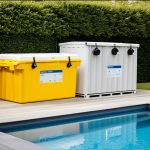Essential regulations and legal standards for safe pool chemical storage in the UK
Understanding UK pool chemical storage regulations is vital for homeowners to ensure safety and legal compliance. Central to these regulations is the Control of Substances Hazardous to Health (COSHH) framework, which mandates that any individual handling or storing pool chemicals must minimize risks to health by assessing hazards and implementing control measures. COSHH compliance requires securely storing chemicals to prevent unauthorized access, contamination, or accidental exposure.
UK pool safety laws also emphasize proper labeling, segregation, and storage conditions to avoid chemical reactions and environmental harm. Failure to meet these standards not only risks personal injury but also legal consequences, as non-compliance can lead to enforcement actions or liability claims.
Topic to read : Transform your uk swimming pool: discover how aquatic plants boost water quality
Homeowners hold responsibility for safely managing chemicals, regularly reviewing storage methods, and maintaining clear documentation. Adhering to these regulations protects families and ensures that pool maintenance remains safe, effective, and within legal parameters. Prioritizing COSHH compliance and UK pool chemical safety laws helps prevent accidents and contributes to sustainable, responsible pool ownership.
Choosing the right storage location
Smart choices for safe chemical storage
Also to discover : Sustainable pool drainage solutions for uk homeowners: creative tips and eco-friendly techniques
Selecting an appropriate pool chemical storage location is critical to keeping chemicals safe and compliant with UK standards. Ideal storage areas should be cool, dry, and well-ventilated to prevent chemical degradation or hazardous reactions. Many UK homeowners opt for dedicated outdoor sheds or locked cupboards separate from living spaces to meet safe storage practices.
Security is paramount. The chosen site must restrict unauthorised access, especially from children and pets, by using sturdy locks and secure fittings. Proper signage indicating hazardous contents adds a layer of precaution. Additionally, protecting chemicals from weather and moisture exposure is essential; dampness accelerates corrosion of containers and can trigger dangerous spills.
It’s advisable to avoid areas prone to flooding or direct sunlight, as extreme temperatures or moisture fluctuations can compromise chemical stability. A shaded, elevated enclosure reduces these risks effectively.
In summary, following a UK homeowner guide for storage location ensures substances remain stable and inaccessible to non-qualified individuals, fulfilling both safety and legal obligations under UK pool chemical storage regulations. Carefully choosing and preparing the storage space plays a significant role in long-term pool chemical safety and regulatory compliance.
Proper separation and organisation of pool chemicals
Safe chemical segregation is critical to prevent dangerous reactions between incompatible pool chemicals. Acids, alkalis, and oxidizers must be stored separately with physical barriers or distinct shelving. This separation reduces the risk of spills mixing and causing hazardous fumes or fires.
Proper organisation also helps minimise confusion. Containers should be arranged systematically, such as grouping all acids on one shelf and bases on another. Clear, legible labelling on each container is essential for quick identification by anyone handling the chemicals. Homeowners should keep an up-to-date inventory and documentation reflecting storage locations and contents.
Additionally, ensuring that different substances do not share storage containers prevents cross-contamination. Pool chemical manufacturers often provide guidelines on which chemicals must remain isolated, so adhering to these is a crucial part of safe storage practices.
By carefully segregating and organising chemicals, homeowners enhance household safety and comply with UK pool chemical safety protocols. This approach substantially lowers the risks of accidental mixing, which can lead to severe injury or property damage. Maintaining order also facilitates routine safety checks and supports effective emergency response if incidents occur.
Maintaining optimal storage conditions
Proper temperature control for pool chemicals is crucial to preserving their effectiveness and safety. Chemicals stored in temperatures that are too high can degrade faster, losing potency or becoming unstable, while freezing conditions can cause containers to rupture or chemicals to separate. Homeowners should aim to keep storage areas within a moderate temperature range, ideally between 10°C and 25°C, adapting as necessary to the UK climate. This helps maintain chemical integrity and reduces hazards.
Storage ventilation is equally important. Well-ventilated spaces prevent the buildup of potentially harmful fumes, especially with volatile substances like chlorine. Good airflow also controls humidity, minimizing moisture accumulation that can corrode containers or trigger accidental reactions.
Using suitable shelving and containment solutions aids both safety and organisation. Shelves should be sturdy, non-reactive, and easy to clean. Secondary containment trays or drip pans catch leaks, preventing chemicals from mixing or damaging property. Elevated shelving also keeps chemicals off damp floors, further guarding against moisture exposure.
By controlling temperature, ensuring consistent ventilation, and employing proper containment, UK homeowners follow safe storage practices that safeguard both household safety and chemical longevity.
Essential regulations and legal standards for safe pool chemical storage in the UK
Understanding and adhering to UK pool chemical storage regulations is critical for homeowners to ensure safe and lawful chemical management. The cornerstone of these regulations is the COSHH (Control of Substances Hazardous to Health) framework, which places responsibility on anyone storing chemicals to assess risks and minimise harm. COSHH compliance mandates secure containment to prevent unauthorised access and accidental exposure.
Homeowners must implement control measures, such as appropriate labelling, segregation, and proper storage conditions, to meet the requirements of UK pool safety laws. These laws are designed not only to protect health but also to avoid environmental damage from chemical misuse or leaks.
Compliance with UK chemical storage legislation reduces risks of injury and legal liabilities, including enforcement penalties. Homeowners should regularly review their storage practices and documentation, ensuring ongoing conformity with COSHH standards. By embedding these regulations in pool maintenance routines, UK residents uphold safety and contribute to responsible chemical stewardship critical for effective and lawful pool ownership.
Essential regulations and legal standards for safe pool chemical storage in the UK
Adherence to UK pool chemical storage regulations is a legal obligation and a practical necessity for all pool owners. Central to these regulations is COSHH compliance, which requires homeowners to perform risk assessments and implement control measures that minimise health hazards from chemical exposure. These responsibilities include ensuring chemicals are stored securely and separately, as improper storage can lead to accidents or legal repercussions under UK pool safety laws.
Homeowners must maintain clear records of stored chemicals and regularly review storage procedures to uphold COSHH standards. This includes proper labelling, segregation, and maintaining safe temperature and ventilation conditions. Failure to comply can result in enforcement actions such as fines or legal liability for injury or environmental damage.
The legislation also mandates that storage areas prevent unauthorised access, especially by children or pets, to reduce the risk of accidental poisoning or exposure. By integrating COSHH compliance into daily routines, homeowners not only follow UK pool chemical storage regulations but also protect their families and contribute to safer community environments. Understanding and meeting these legal standards establishes a foundation for responsible, safe pool chemical management in the UK.
Essential regulations and legal standards for safe pool chemical storage in the UK
UK pool chemical storage regulations primarily revolve around the COSHH compliance framework, which places clear responsibilities on homeowners to manage hazardous substances safely. COSHH (Control of Substances Hazardous to Health) requires detailed risk assessments to identify potential hazards related to chemical use and storage. Homeowners must implement control measures that reduce exposure risks, ensuring chemicals are stored securely and labelled correctly in line with UK pool safety laws.
One key COSHH responsibility is preventing unauthorised access by children or pets, which is critical for legal compliance and household safety. This involves using locked storage and appropriate signage. UK pool safety laws also mandate clear segregation of incompatible chemicals and maintenance of storage conditions that prevent chemical degradation or accidental reactions.
Regular review and documentation of chemical inventories and storage procedures ensure sustained compliance with UK pool chemical storage regulations. Failure to adhere to these legal standards can lead to enforcement actions, fines, or liability for injury or environmental damage.
By rigorously following COSHH compliance and UK pool safety laws, homeowners safeguard their families and communities, maintaining a legally sound foundation for effective and safe pool chemical management.
Essential regulations and legal standards for safe pool chemical storage in the UK
Adhering to UK pool chemical storage regulations is fundamental for safe and lawful management of pool chemicals at home. These rules are primarily framed by the COSHH compliance system, which requires homeowners to perform thorough risk assessments and implement control measures that minimise health risks from hazardous substances. COSHH requires secure containment, ensuring chemicals are stored safely to prevent unauthorized access and accidental exposure.
Under UK pool safety laws, homeowners must maintain proper labelling, segregation, and storage conditions consistent with COSHH mandates. This includes preventing children or pets from accessing chemicals through locked storage or restricted areas. Regular reviews of chemical inventories and storage procedures form part of ongoing compliance responsibilities, reducing risks of injury or environmental harm.
Failure to comply with UK pool chemical storage regulations can lead to enforcement actions, including fines and potential legal liability for accidents. Compliance not only protects health and the environment but also ensures pool owners meet their legal obligations.
In summary, integrating COSHH compliance, understanding UK pool safety laws, and following secure storage protocols provide a robust framework safeguarding families and communities from chemical hazards in domestic pool environments.










